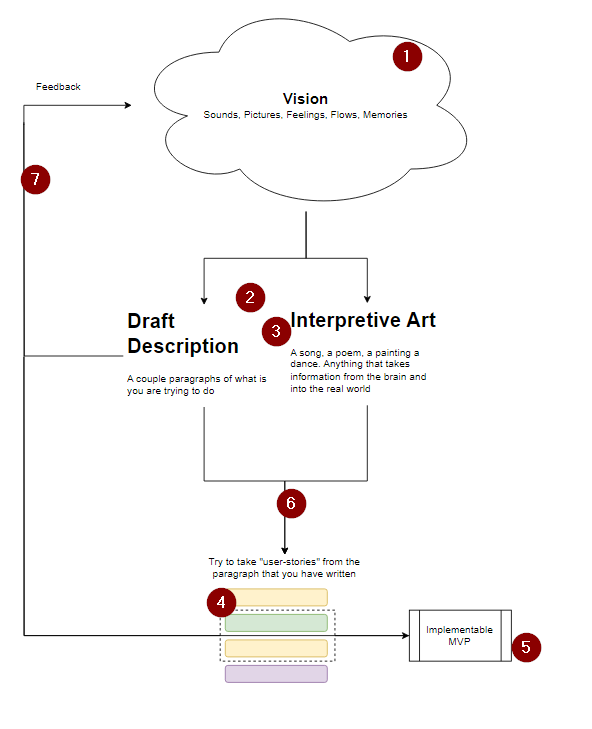If you are of the entrepreneurial mindset you get hit with ideas and visions all the time. Sometimes you ponder about time travel, sometimes about a teleportation device and sometimes about something more pragmatic like how to get more miles from your electric car. Sometimes the ideas can take you over and consume all of your brain capacity. It’s annoying especially when it is right before bed time. I like to write them down when that happens and that helps to calm the brain. Not all ideas that I write down are practical, but unless considered they might disappear into the mental abyss they came from. What I am generally curious about is how to make all of those ideas practical. How can I slice them into practical chunks and perhaps turn part of them into action. This article is exactly about that, how to take the ideas and visions that come to you and convert them into actionable practicalities.
Let’s start with a general diagram that I like to refer to when thinking about this process.

What you can see here is a flow that I apply to anything that is interesting that comes into my mind. It starts as some sort of vision (1), either a sound, a feeling, a visual experience or an ‘aha’ moment. I hope that all of you had a chance to experience this beautiful phenomenon.
The Process
Initially it is just a feeling, almost like a result of a boolean function. There it is - an idea! Usually not much surrounds the idea in the head and I go through the process of teasing what it can really be. I either sit down and try to write down (2) everything that I am thinking at the moment, all of the relevant artifacts that keep popping in. I register the state of my feelings and any memories that come in. Sometimes I think of structures, hierarchies or abstract relationships and those I generally jot down as diagrams. It is still a little bit messy at this moment and I continue to iterate through my imagination. If I am stuck trying to extract thoughts onto paper, then I resort to more creative means and work on relating the existing content into a song or a poem (3). It is different for everyone, especially for the artists who had the idea of a song in the first place.
Once a more legible draft is in place, the next step is teasing out the actionable bullet points(4) that can be turned into something useful. I typically try rearrange the sentences, filter out the key nouns, verbs and context. It’s never a perfect conversion to bullet points and there is signal loss, but it is one of the more practical methodologies. If you practice this approach, over time it will become second nature. The last step is to group those bullet-points/user-stories into something that can resemble an MVP(5) that you can take back to the clients and market for testing and usability.
Improving Transitions/Conversions/Integrations (6)
When you are following this process, it is easy to notice that most of the actions are converting mental data from one domain into another, from more abstract into more concrete. As you get towards the end of the process the more practical actions you can execute become. Most of my experience has been focused on perfecting and stimulating more accurate conversions. Here are some of the ways that worked for me:
Vision
- Have more client discovery calls
- Step back, go for a walk, go to the gym, have your subconscious sort out inconsistencies
- Perform idea marriages from your previous efforts
- Create contrast - Think of the idea that is opposite to what you are trying to do
- Putting things down on paper
- Start with simple sentences of shapes and expand
- Add colors or play with adjectives
- Look up all existing adjectives or descriptors and see which one fits your vision description better
- Start writing even though you have nothing to write about, a process similar to Morning Papers, until your mind volunteers a path forward
- Start drawing and redrawing, iterating on a diagram or an image, eventually it will align
User-Stories
- Step through every sentence and see if you can rephrase it as actionable bullet points
- Try doing the same with each word. Can each word add additional variations on the story?
- Ask chatGPT to rephrase the whole paragraph and see if that triggers something for you
MVP
- The goal is to create something that is useable and can create a little bit of value
- Pick the features that are the easiest to implement and demonstrate the concept well
Feedback
This process improves with additional iterations. The first one is the hardest. Getting the idea through the pipeline all the way to the MVP initially is the hardest task. Make sure that you are putting the least amount of effort possible at each step. This way you can get to the revisions faster. The goal is not to perfect the outcome on the first try but to draw it out through a repetitious process and channeling a lot of feedback of the process back to the centers of its origination. At some point you might start thinking that you almost got it and if you spend a couple more hours, days, weeks on the process it will improve. That is true, but it will be guided by your own intuition that is frequently biased. I recommend that you step out at this point in time and solicit feedback before the flow is too perfect and you are too tied to the outcome.
Conclusion
I've been utilizing this process for several years now, and it has significantly contributed to the sharpening and refinement of my thoughts and conclusions. This method has proven invaluable in my journey of intellectual and creative growth, offering clarity and depth to my work. I am confident that it can offer the same benefits to you, aiding in the development and enhancement of your own ideas. My hope is that this approach will be as enriching and beneficial to you as it has been to me.
Let's schedule a session to dive in deeper!
https://mentorcruise.com/mentor/vladimirbaranov/







